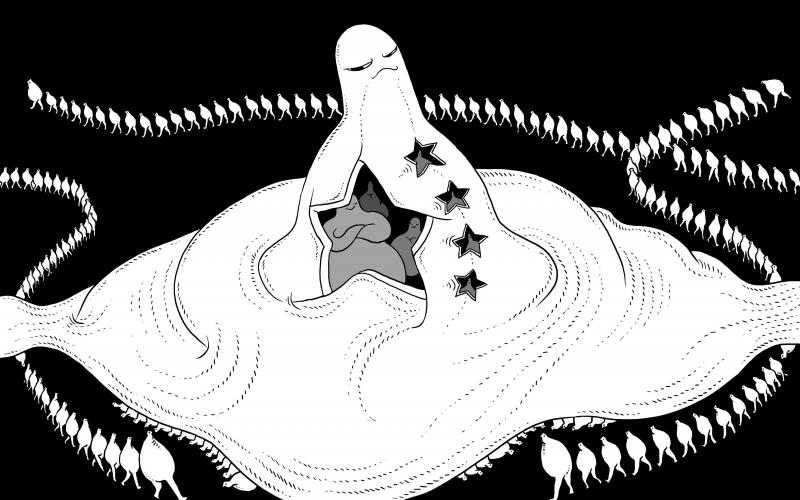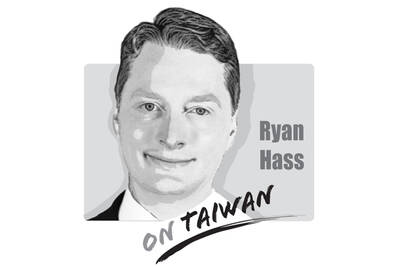When Wang Zhenyu moved out of his small village in central Henan Province to the coastal city of Dalian at 18, he was astonished.
“It was like culture shock for me, even though it was just a big city in my country, not a foreign land,” Wang said.
A few years later when he was enrolled in Peking University as a graduate student, he found that many fewer students in the country’s top university came from a background similar to his. Growing up in a small village of 2,000 farmers, many of Wang’s childhood friends had dropped out of school after finishing their nine years of compulsory education.

Illustration: Mountain People
Now with a decent academic job, Wang experiences “reverse culture shock” every time he returns to his village for the lunar New Year holiday.
“When I get together with my childhood friends in my village, the number of attendees drops every year. Some went out to be migrant workers in big cities then never came back, while others have gotten used to life as villagers,” Wang said. “It’s the poverty that is dividing us. It’s a vicious circle.”
As China grows wealthier as a nation, its gap between rich and poor, urban and rural also increases. Although the country’s official Gini coefficient, a measurement of income inequality, has improved slightly over the past few years, experts have also questioned its accuracy.
Chinese Premier Li Keqiang (李克強) in May revealed that 600 million citizens only earn about 1,000 yuan (US$155) per month, indicating the extent of the problem.
Many worry that the COVID-19 pandemic might have reversed the trend.
TREND REVERSAL
The story of Wang’s home village is common in China. After all, 40 percent to two-thirds of China’s 1.4 billion people still live in rural areas.
Wang’s own path from poverty to the ranks of the educated middle class is “very rare,” said Scott Rozelle, a development economist at Stanford University’s Freeman Spogli Institute for International Studies.
“How much Wang’s childhood friends and their fellow villagers can contribute to the country’s changing labor market matters for the future of the world’s second-largest economy.
However, the reality does not look optimistic,” added Rozelle, who has spent the past 30 years researching China’s labor force and its rural-urban divide.
As the Chinese Communist Party (CCP) celebrated its centennial last week, Chinese President Xi Jinping (習近平) vowed to keep it in power, but some analysts have said that the ever-increasing rural-urban divide — and the division between rich and poor — pose the biggest uncertainty to China’s society, as well as a threat to the longevity of the 92 million-strong political organization.
“Although the CCP does not face any electoral pressure, anger over inequalities could undermine its authority and trigger resentment if it fails to take actions that alleviate the people’s pain,” said Yu Jie (余杰), senior research fellow on China at the London-based think tank Chatham House. “The Chinese people are watching closely, so are foreign nations, not least the US.”
“It is all about citizens’ expectation,” said Rozelle, who coauthored Invisible China: How the Urban-Rural Divide Threatens China’s Rise.
“If those at the bottom of the social strata begin to lose hope of a better future as a result of the increasing wealth gap and stagnant wages, we are very likely to see the emergence of a polarized society,” he said. “This is not good for the stability of the world’s second-largest economy.”
It is not just researchers who are concerned about the urgency of the problem.
In January, Xi said that the country’s wealth gap is not just an economic issue, but a political one that could threaten the legitimacy of the CCP.
“Achieving common prosperity is not just an economic issue, but a significant political one that matters to the party’s basis to rule,” Xi told his provincial and ministerial-level cadres.
“We absolutely cannot allow the rich-poor gap to increase bigger and bigger, resulting in the poor poorer and the rich richer,” Xi said. “We should absolutely not allow an insurmountable gap between the rich and the poor.”
LITTLE CHANGE
Despite the political rhetoric from the nation’s highest level, very little change is happening on the ground, Rozelle said.
China needs long-term and sufficient investment into programs such as early childhood education and rural health nutrition, he said.
“But just like the US, although political leaders understand the significance of these issues, as the effects of such an investment would not be seen immediately, it makes it less of a priority,” Rozelle added.
The stakes are high for China.
For example, a lack of early childhood education is making the country’s labor force less sophisticated in the long term, Rozelle said.
In one of his studies in China’s rural Gansu and Shaanxi provinces, Rozelle measured the cognitive abilities of students who were 13 to 14 years old and found that about half of them would be considered delayed enough to qualify for special education programs in developed nations.
“In the past, China’s rural-urban divide enabled the country’s urban factories to exploit cheap manufacturing labor from rural areas, but many of these jobs are disappearing, as the country moves up the economic ladder,” said Jan Knoerich, a senior lecturer in the economy of China at King’s College London.
“Wages are going up in China, and other countries — such as Vietnam and others in Africa — are getting more competitive in labor cost,” Knoerich said.
Rozelle agreed, adding that this changing economic structure would not only have profound economic implications for China, but also social and political effects.
“As a result, many of those people are not going to be able to participate in the new economy,” Rozelle said. “They are going to be forced into a peripheral and informal economy. It not only won’t be productive for the society, and many of them may end up being a drag for China.”
‘MIDDLE-INCOME TRAP’
Chinese economists have for many years worried about the “middle-income trap,” a situation where a country that has reached a certain level of income gets stuck for a long time.
According to the World Bank, only a handful of economies — including South Korea and Singapore — have risen from middle income to high income since 1960.
Even when they were still middle-income economies, the average share of the labor force with a high-school education was 72 percent, Rozelle found.
However, 2015 census data for China showed that only 30 percent of the nation’s workers aged 25 to 65 had attended high school — a figure below the average of other middle-income countries (36 percent) and much lower than the average for nations in the Organisation for Economic Co-operation and Development (78 percent).
“Most middle-income countries don’t make it, such as Malaysia. This is what’s challenging for China, to move beyond manufacturing and low-skilled labor, and arrive at a more advanced economy characterized by booming hi-tech and services sectors,” Knoerich said.
Wang has thought about this since recent visits to his home village in Henan.
Now at the age of 34 and living with his wife in China’s wealthy southern Guangdong Province, Wang considers himself “a lucky one” — or “a success story” from his poor village.
“I don’t exactly know how I did not end up like my childhood friends in the village, but I’m now helping my nine-year-old nephew to get into a better school and receive a proper education,” he said. “No one wants their next generation to be left behind.”
When US budget carrier Southwest Airlines last week announced a new partnership with China Airlines, Southwest’s social media were filled with comments from travelers excited by the new opportunity to visit China. Of course, China Airlines is not based in China, but in Taiwan, and the new partnership connects Taiwan Taoyuan International Airport with 30 cities across the US. At a time when China is increasing efforts on all fronts to falsely label Taiwan as “China” in all arenas, Taiwan does itself no favors by having its flagship carrier named China Airlines. The Ministry of Foreign Affairs is eager to jump at
The muting of the line “I’m from Taiwan” (我台灣來欸), sung in Hoklo (commonly known as Taiwanese), during a performance at the closing ceremony of the World Masters Games in New Taipei City on May 31 has sparked a public outcry. The lyric from the well-known song All Eyes on Me (世界都看見) — originally written and performed by Taiwanese hip-hop group Nine One One (玖壹壹) — was muted twice, while the subtitles on the screen showed an alternate line, “we come here together” (阮作伙來欸), which was not sung. The song, performed at the ceremony by a cheerleading group, was the theme

Secretary of State Marco Rubio raised eyebrows recently when he declared the era of American unipolarity over. He described America’s unrivaled dominance of the international system as an anomaly that was created by the collapse of the Soviet Union at the end of the Cold War. Now, he observed, the United States was returning to a more multipolar world where there are great powers in different parts of the planet. He pointed to China and Russia, as well as “rogue states like Iran and North Korea” as examples of countries the United States must contend with. This all begs the question:
In China, competition is fierce, and in many cases suppliers do not get paid on time. Rather than improving, the situation appears to be deteriorating. BYD Co, the world’s largest electric vehicle manufacturer by production volume, has gained notoriety for its harsh treatment of suppliers, raising concerns about the long-term sustainability. The case also highlights the decline of China’s business environment, and the growing risk of a cascading wave of corporate failures. BYD generally does not follow China’s Negotiable Instruments Law when settling payments with suppliers. Instead the company has created its own proprietary supply chain finance system called the “D-chain,” through which